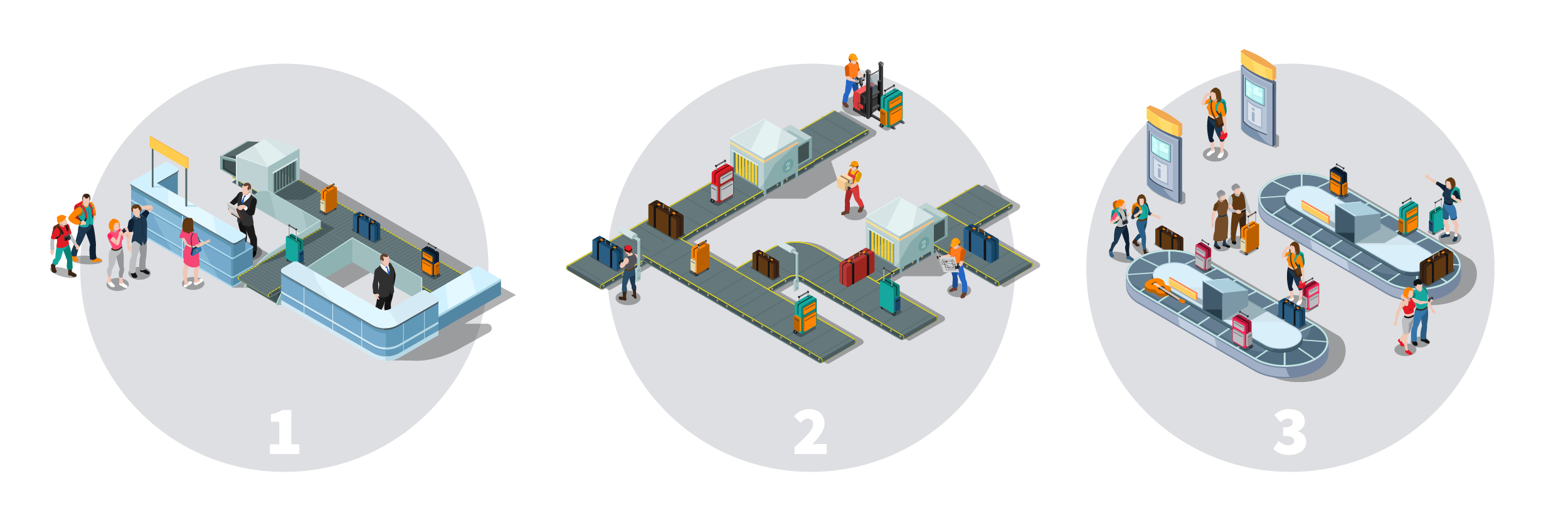How does the airport luggage handling system work?
Discover the baggage tricky journey: from the check-in to the boarding gate, from the arrival gate to the collection area.
The Baggage Handling System, or BHS, is the baggage sorting handling system used in airports. Often, the airport prestige and the ability of the infrastructure in attracting the interest of the big airline companies come from the BHS level of efficiency. Travelers' satisfaction is a fundamental parameter to guide airlines choosing the stopovers for their flights.
The objective for an efficient BHS is moving luggage from one side to another of the airport with a system able to allow a transfer that lasts much as the one of the passenger that owns the suitcase. If luggage move slowly, the result will be frustrated travelers waiting for suitcases and that may lose connections because of these delays. If the transfer is too fast, baggage may arrive before passengers.
Each airport has its own needs and size: in some airports, the transfer could last the time of a walk, but in some other airports passenger may have to take a train. Usually, in medium/large airports, the baggage handling structure is an automatic system made of conveyor belts, switches called "pushers" and barcode readers (or RFID labels).

A baggage handling system tasks are mainly three:
- Moving luggage from the check-in to the boarding gate;
- Moving luggage from one gate to another during transfers;
- Moving luggage from the arrival gate to the baggage collection area.
1. Check-in
The conveyor belt starts from the desk of the check-in (that can also be unattended), where the operator registers luggage with the passenger name, finds the whole travel itinerary and prints one or more tags to attach to each suitcase. The tag is a label that includes all the information related to the flight, also the final destination and any other foreseen stopover, together with a 10-digit barcode, unique for each suitcase.
Immediately after the check-in operations, baggage pass through a system able to handle automatic barcodes, that scan 90% of the suitcases. The remaining suitcases are sent to another conveyor and will be manually scanned. Through the 10-digit barcode reading, we can have get the position of the baggage at any time.
2. From one gate to another
The path of the conveyor belts may be structured, as a road system. In any case, once that the suitcase have been registered thanks to the information included in the tag, the sorting function exactly knows its final destination and its itinerary, and - through conveyors and intersections - our baggage can be automatically sent to almost all final destinations. At the end of all these steps, the baggage is finally loaded onto the plane.
3. Baggage collection
The baggage collection at the end of the journey is handled by the belt that delivers luggage to passengers, where the suitcases that have just been unloaded from the airplane have been directed, thanks to special loading platforms. In this case also, the right delivery path is chosen thanks to the label put on the suitcase. Baggage that have not been automatically recognized go toward a manual identification and, if this kind of identification is not possible anymore, they will be brought to the lost baggage office.
That's how airport logistics for luggage works. Automatic systems and accurate timings are the ideal combo for a high quality service; furthermore, check-in operations confirm their basic role that guarantees the accuracy of the whole handling system.
Custom's solutions for baggage tags
Custom S.p.A. offers printing solutions designed to optimize check-in operations and ensure their efficiency. The company uses barcode and RFID technologies, applying them together and proposing barcode printers that can have the RFID encoder also. The system is completed by VeriPrint®, the innovative hardware and software solution that automatically digitizes printer tickets to prevent printing defects and forgeries
Discover all the airport solutions checking our website!
This article was originally published on March 20, 2016. Updated on September 8, 2022.
08/09/2022刊登于 Technological Innovations




